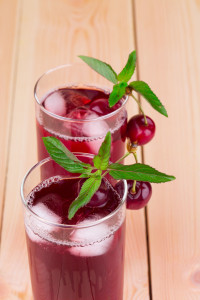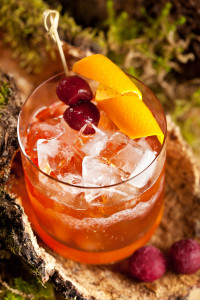 Shrubs and Switchels! It sounds more like a project for an arborist than a “new discovery” for mixologists. However, mixologists have “discovered” the two, and are quickly realizing that what was ancient can be new and exciting in the modern era of mixology.
Shrubs and Switchels! It sounds more like a project for an arborist than a “new discovery” for mixologists. However, mixologists have “discovered” the two, and are quickly realizing that what was ancient can be new and exciting in the modern era of mixology.
Shrubs and switchels have a rich history with accounts of “drinking vinegars” dating back to 15th century England’s use as medicinal cordials. Shrubs are an intriguing blend of fruit, sugar, and vinegar created to preserve fruit long after harvest. Recipes and methods for making shrubs may vary, but the result is a delightful liquid that captures the essence of fresh fruit. A proper shrub has a flavor that’s both tart and sweet, so it stimulates the appetite while quenching thirst.
Switchels are a blend of molasses (honey or maple syrup), water, vinegar, and usually ginger. In Laura Ingalls Wilder’s book The Long Winter, there is reference to a switchel-like drink claiming how it quenched the thirst without upsetting the stomach after hot work making hay.
Using shrubs and switchels to create refreshing beverages is truly an American story that came about in the 18th century. A 19th century magazine noted, “When the thermometer ranges among the nineties, it is not so much a question of what we shall eat as what we shall drink.” (Surely, SWE members would agree!)
Physicians cautioned that ice water, which was difficult to obtain and maintain, was a “very grim and deleterious beverage, every glass of which should be labeled with skull and crossbones.” Too much ice water, they believed, could cause indigestion, bloating and other more serious problems. Shrubs and switchels provided an acceptable alternative, especially as these drinks would “cheer, but not inebriate.” It was not long after, with  further American ingenuity, they were served with whiskey and brandy. In 1862 when Jerry Thomas’ groundbreaking book The Bar-Tender’s Guide was published, shrubs had become so ingrained in our cocktail culture that several were featured.
further American ingenuity, they were served with whiskey and brandy. In 1862 when Jerry Thomas’ groundbreaking book The Bar-Tender’s Guide was published, shrubs had become so ingrained in our cocktail culture that several were featured.
Fast forward to today and you will find a collection of mixologists across the country reaching back through history to reclaim vinegar’s more palatable past. According to Tony Abou-Ganim, superstar bartender and author of The Modern Mixologist, “Skilled mixologists construct cocktails not from set recipes, but from building blocks of base spirit, modifiers and accents. The key is to balance between the flavors of alcohol, sweet, acid and bitter” Shrubs and switchels offer an alternative to lemons and limes for adding that acidity.
A number of shrubs are now available commercially, but they are also easy to make. Just mix fresh fruit, sugar and vinegar together and let them steep until the flavors blend and balance to your taste. Essentially any fruit from berries to melons and apples to rhubarb can be made into a shrub. A good rule of thumb is one part fruit, one part sugar, and one part vinegar. You can then adjust to taste.
There are two basic methods to create shrubs; hot or cold.
The hot method: This method is faster, but creates a jammy result. This method works best in preserving harder fruits like apples and rhubarb. Add equal parts sugar and water to saucepan, heat and stir until the sugar dissolves. Add fruit and cook on low heat until the fruit juice blends into the syrup. Let the mixture cool, strain and then add vinegar to the syrup. Bottle and let rest in the refrigerator for a couple of weeks to further integrate.
The cold method: This method takes longer, but gives a fresher fruitier result. This method works best in preserving delicate fruits and berries. Steep the fruit in sugar for 24 hours (or longer) in a covered container in the refrigerator. After a day or two, your fruit should be swimming in juice and syrup. The longer it sits, the more flavorful the shrub will be. Add vinegar and let the mixture sit again for 24 hours. Strain the syrup from the solids and bottle the shrub. Shake the bottle well before using as some sugar may settle to the bottom.
 Regardless of the method all shrubs mellow with time. The tartness and sweetness remain, but they start to harmonize after a few weeks in the fridge.
Regardless of the method all shrubs mellow with time. The tartness and sweetness remain, but they start to harmonize after a few weeks in the fridge.
In addition to the choice of fruits, experimentation can be made with the type of sugar and vinegar used. White sugar is most versatile, but brown, raw, honey and molasses can have some interesting results. Apple cider vinegar is most commonly used, but others have had success with white wine, red wine, and even balsamic vinegar.
Shrubs can add depth and complexity to a cocktail, but be careful. Since they are already acidic, they don’t always play well with citrus juice. Use a light hand and taste as you’re building your ingredients.
I have experimented with substituting shrubs in place of the acid component in my cocktails. I use a base spirit, a shrub, a complementary liqueur or cordial, and bitters to create my concoctions. While not all have been successful, the creative process has been fun! Two cocktails that stood out as triumphs were one made with rum, blackberry shrub, ginger liqueur and lime bitters and another made with brandy, lemon shrub, orange liqueur and orange bitters. I look forward to my continued research in this “new discovery” of ancient “drinking vinegars”.
What are some of your uses for shrubs and switchels? Please share your experiments and recipes as we dabble with history.
Post authored by Brenda Audino, CWE. After a long career as a wine buyer with Twin Liquors in Austin, Texas, Brenda has recently moved to Napa, California (lucky!) where she runs the Spirited Grape wine consultancy business. Brenda is a long-time member of SWE and has attended many conferences – be sure to say “hi” at this year’s conference in NOLA!
Are you interested in being a guest blogger or a guest SWEbinar presenter for SWE? Click here for more information!